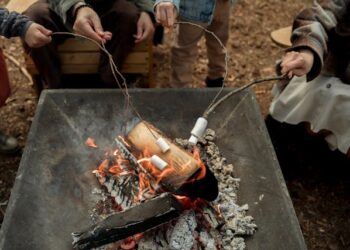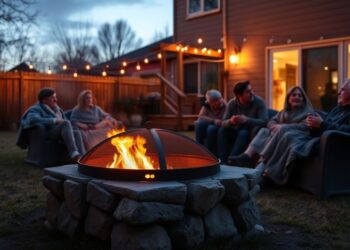Discover the ultimate guide to choosing, installing, and using a fire pit ring insert to elevate your outdoor living space.
Let’s start with a question nobody asks but everyone should: what’s the one backyard addition that gets people outside, sparks actual conversation, and doesn’t require Wi-Fi to be fun? You guessed it, the humble but wildly underrated fire pit ring insert.
Now, if you’re imagining a decorative accessory that sits pretty while doing nothing useful, let’s kill that image right now. A fire pit ring insert isn’t a lawn ornament, it’s a core structural element that transforms your backyard fire pit from a makeshift hole in the ground to a lasting, safe, and functional gathering point.
But here’s the real kicker: most people who build fire pits without one end up regretting it. Why? Because they learn (the hard way) that intense heat and raw soil don’t mix. Concrete cracks, bricks loosen, and that rustic DIY vibe turns into a crumbling mess. The insert is the hero that prevents all that drama.
This article isn’t just about what a fire pit ring insert is, it’s about how it changes everything: the look, the feel, the safety, and the longevity of your fire feature. So, grab a chair, or better yet, imagine sitting on a log near a warm fire, and let’s dig deep.
What You'll Discover:
The Anatomy of a Fire Pit Ring Insert
What Exactly Is It?
At its core, a fire pit ring insert is a cylindrical metal liner, usually made from heavy-duty steel, that goes inside your fire pit structure. Think of it as the internal skeleton, the part that holds everything together when the heat gets wild.
Most inserts are round (hence the term “ring”), though you’ll find square and rectangular versions too. They vary in size, thickness, and finish, all of which we’ll break down later.
Why Is It So Important?
Because fire isn’t gentle. Over time, exposure to high temperatures warps rock, damages mortar, and deteriorates anything not built to withstand the burn. A good insert solves all of this by:
- Shielding the outer walls of your pit from direct flame
- Channeling heat upward and inward, making fires hotter and more efficient
- Preventing soil erosion or concrete cracking
- Making cleanup dramatically easier
And let’s not ignore aesthetics: a blackened steel ring gives your fire pit a clean, finished look that makes everything feel intentional rather than improvised.
Choosing the Right Fire Pit Ring Insert
Now this is where most people get tripped up. They see a few sizes on Amazon or the local hardware store and just pick one. Big mistake.
Size: Not Just Diameter, Depth Matters
When sizing your fire pit ring insert, people usually just measure diameter, 24″, 30″, 36″, 48″, etc. But here’s what matters just as much: depth.
A shallow ring (say 6-8 inches deep) might work fine for a temporary setup or above-ground fire bowl. But if you’re building an in-ground or built-in pit, aim for 12 inches or more. This ensures that the flames stay centered and the ring holds enough heat for a longer burn.
Pro tip: Always measure the inner width of your pit, not the outer. The ring should nest inside with at least a half-inch of space all around for expansion and airflow.
Steel Thickness: Why Gauge Is a Big Deal
Steel gauge refers to thickness, and lower numbers mean thicker steel. Don’t get suckered by a cheap 16-gauge ring that warps after five fires. Go for at least 10- or 12-gauge. Anything thicker than that (like 7-gauge) is practically indestructible and will outlast your patio furniture.
Coating and Finish
There are three main types:
- Raw steel: Looks rugged but rusts fast. Expect patina.
- High-temp painted steel: Sleek and rust-resistant but can flake over time.
- Stainless steel: Beautiful and tough, but pricey.
If you’re going for low-maintenance durability and aesthetics, high-temp coated steel is your sweet spot. But if you live near the ocean or in a wet climate, stainless is worth the investment.
Built-In vs Portable Fire Pit Rings
Permanent Installations: The Long-Term Love Affair
If you’re ready to commit, like, pour-concrete levels of commitment, a built-in fire pit ring insert is the way to go. You can pair it with:
- Brick or stone surrounds
- Paver seating areas
- Custom grills or spark screens
These setups not only add serious home value, but they also become the social center of your space. A built-in insert means you’re in it for the long haul, and you want every burn to be flawless.
Portable Fire Rings: For the Nomadic Flame-Lover
Need flexibility? Rent your space? Or just love tailgates, campsites, and spontaneous bonfires? A portable fire pit ring insert gives you the structure of a pit without anchoring it to one spot.
Many even come with folding legs or carry bags. They’re not as heavy-duty, but they give you freedom. Just make sure it’s legal to use in your area, some parks and campgrounds have strict fire ring rules.
Installation: From Cardboard Box to Glowing Hearth
Let’s walk through what actually goes into setting up a fire pit ring insert the right way.
Tools You’ll Need:
- Tape measure
- Shovel (for in-ground setups)
- Level
- Gravel or lava rock (for drainage)
- Bricks or pavers (for outer wall)
- Fireproof adhesive (if using masonry)
- Gloves (seriously, that steel gets hot)
Step-by-Step:
- Choose your location wisely Clear, level ground, away from overhanging trees, fences, and buildings. Check local codes; you might need a 10-foot clearance in every direction.
- Mark the diameter Use a rope and spray paint to mark the outer and inner circles. Your fire pit should be at least 36″ across for comfort.
- Dig the foundation (for in-ground pits) Go about 6-12 inches deep. Line the bottom with gravel for drainage.
- Install the ring insert first This sets the framework. Use it to shape the outer walls of your pit.
- Build the walls around the ring Use fire-safe bricks, stones, or concrete blocks. Leave room for airflow at the bottom if you want better combustion.
- Test burn it Do a low-flame trial run before hosting a big get-together. Make sure it draws well and feels secure.
Practical Tips Most Guides Skip
Let’s get brutally honest, here’s the stuff you won’t find in the manufacturer’s manual.
Rust Happens, Plan for It
Even the best fire pit ring inserts rust over time. Don’t panic. Minor rust gives character. Major rust means it’s time to clean and recoat with high-temp paint (like Rust-Oleum 2000°F spray).
Don’t Burn Trash or Treated Wood
Besides being bad for the environment, burning pressure-treated wood releases toxins that will eat away at your insert. Stick with seasoned hardwoods like oak, hickory, or maple.
Add a Cooking Grate
Want more than ambiance? Add a swing-away cooking grate. It turns your fire pit into a live-fire grill. Just make sure your ring insert can handle the weight.
Cover It When Not in Use
Moisture buildup is what kills steel. A simple waterproof cover or a metal lid will extend the life of your insert by years.
Fire Pit Ring Insert Ideas That Go Beyond Basic
Let’s stretch the imagination a little. Here are radically underrated ways people are using fire pit ring inserts:
- Double-ring designs: One ring inside another, with a gap for ventilation, crazy efficient and burns super clean.
- Glow-in-the-dark accents: People embed glow rocks around the insert for a surreal nighttime effect.
- Built-in beer cooler: Yep, someone made a pit with a side cooler compartment. Because genius comes in flames and frosty bottles.
- Rotisserie add-ons: If you’re feeling medieval, you can rig a rotisserie spit to your ring insert. Wild, but functional.
- Vertical fire towers: Start with a wide base ring and build upward for a chimney-like fire pit that heats like a furnace.
Key Takings
- A fire pit ring insert is essential for building a safe, efficient, and long-lasting fire pit.
- Size and steel thickness matter. Go deeper and thicker than you think, it pays off in durability.
- Choose between portable and permanent setups based on your lifestyle and space.
- Use high-temp coated or stainless steel if you want low-maintenance performance.
- Install it properly, from site selection to gravel drainage and masonry, to avoid costly mistakes.
- Upgrade your insert with grates, spark screens, or glow features for added function and style.
- Keep it covered and rust-free, and you’ll have a fire feature that lasts decades.





